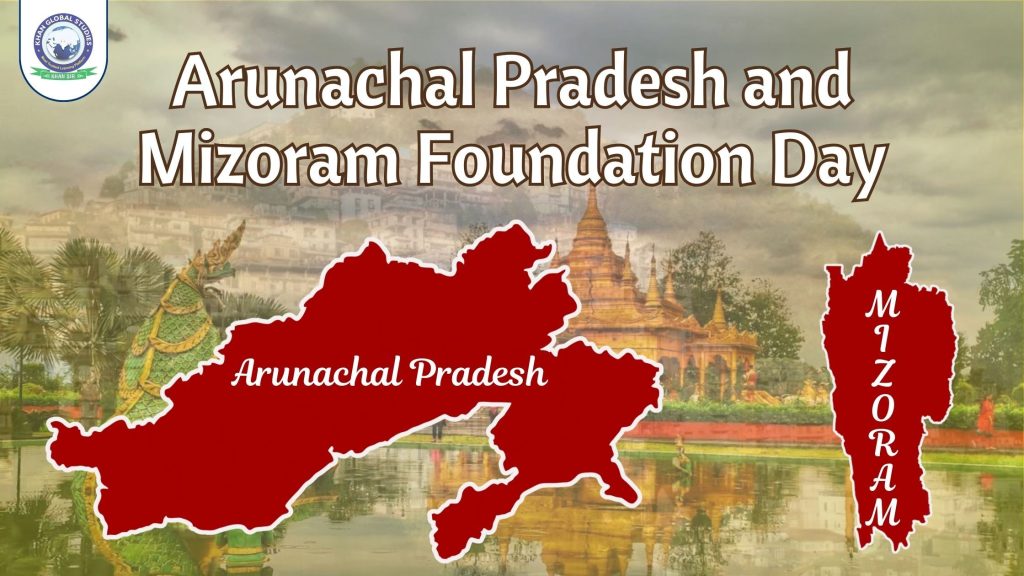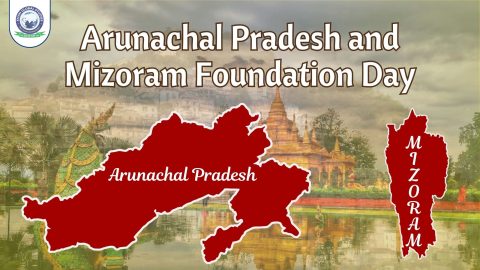Every year on 20th February, Arunachal Pradesh and Mizoram celebrate their Foundation Day. This day marks the formation of these northeastern states and recognizes their cultural, geographical, and historical significance. On 20th February 1987, both states were granted full statehood. Let’s explore how these states came into existence, their history, and their unique features.
Arunachal Pradesh – The Land of the Rising Sun
Early History
- Arunachal Pradesh was previously known as the North-East Frontier Agency (NEFA).
- It was originally part of Assam, but in 1954, it was administratively separated as NEFA.
- Ancient Indian texts like the Mahabharata and Puranas mention the region.
- The name Arunachal means “Land of the Rising Sun.”
- The region has influences from Tibetan, Burmese, and Assamese cultures.
- In medieval times, it was a battleground between Ahom rulers of Assam and Tibetan rulers.
British Rule & Formation of NEFA
- During British rule, Arunachal Pradesh was under Assam’s administration.
- In 1914, the British created the North-East Frontier Tract, which was renamed NEFA in 1954.
- After India’s independence in 1947, NEFA was under the direct control of the central government.
Formation of Arunachal Pradesh
- In 1972, Arunachal Pradesh became a Union Territory.
- On 20th February 1987, it was declared a full-fledged state of India.
Why was Arunachal Pradesh made a separate state?
- Geographical Challenges – It is a mountainous region, making administration from Assam difficult.
- Tribal Diversity – The state has multiple tribes with distinct languages, traditions, and customs.
- Security Concerns – It shares borders with China, Bhutan, and Myanmar. After the 1962 India-China war, its strategic importance increased.
- Political & Administrative Needs – Separate governance was required for efficient administration.
Key Features of Arunachal Pradesh
- Easternmost state of India – The first place in India to witness sunrise.
- Rich Tribal Culture – Home to 26 major tribes and over 100 sub-tribes, including Nyishi, Monpa, Adi, Apatani, Mishmi, and Tagin.
- Natural Beauty – Famous places include Tawang Monastery, Sela Pass, Namdapha National Park, and Bum La Pass.
- Buddhism & Tawang Monastery – Tawang Monastery is India’s largest and the world’s second-largest Buddhist monastery.
- Strategic Military Importance – Houses significant Indian Army bases due to its border with China.
Mizoram – The Land of Bamboo and Peace
History & Formation
- Mizoram was originally part of Assam and was called the Lushai Hills District.
- During British rule, it was under separate administration within Assam.
- In 1950, it was declared a special district of Assam.
- In 1972, it became a Union Territory.
- On 20th February 1987, it was granted full statehood.
Events During British Rule
- In the 1890s, the British formed the Lushai Hills District to control Mizo tribes.
- Despite resistance, it remained part of Assam until 1947.
Mizo Rebellion and Demand for a Separate State
- Special District in 1950 – After India’s independence, Lushai Hills was made a special district within Assam.
- Famine of 1959 (Mautam Crisis) – In 1959, Mizoram faced a severe famine known as “Mautam.” Due to the neglect of the Assam government, dissatisfaction grew among the Mizo people.
- Formation of Mizo National Front (MNF) in 1961 – As a result of this discontent, the Mizo National Front (MNF) was formed, demanding independence for Mizoram.
- Mizo Rebellion of 1966 – In 1966, MNF launched an armed rebellion against the Assam government, which was later suppressed by the Indian Army.
- Peace Accord (1986) – In 1986, a peace agreement was signed between the Government of India and MNF, leading to an agreement to grant statehood to Mizoram.
Why was it made a separate state?
- Culture and Language – The Mizo tribes were different from Assam in terms of language, food, traditions, and customs.
- Mizo Rebellion (1966-1986) – In 1966, the Mizo National Front (MNF) led an armed rebellion against the Assam government. After the Mizo Peace Accord in 1986, Mizoram was granted statehood.
- Administrative Reforms – To preserve the unique identity of the Mizo tribes and ensure smoother governance, Mizoram was made a separate state.
- India-China War (1962) – In 1962, China invaded Tawang and other parts of Arunachal Pradesh. This incident made the Indian government focus on strengthening security and administration in the region.
- Political and Administrative Improvements – In 1972, the North-East Frontier Agency (NEFA) was separated from Assam and made a Union Territory.
- Full Statehood (1987) – On 20th February 1987, Mizoram was granted full statehood, becoming the 24th state of the Indian Republic.
Key Features of Mizoram
- Land of Bamboo & Forests – About 90% of Mizoram is covered with forests and it is a major producer of bamboo in India.
- Unique Mizo Culture – The society follows the principle of “Tlawmngaihna”, meaning selflessness and helping others.
- Festivals & Dance – Major festivals include Chapchar Kut, Mim Kut, and Thalfavang Kut. The Cheraw (Bamboo Dance) is a famous traditional dance.
- Peaceful State – After the 1986 Peace Accord, Mizoram became one of India’s most peaceful states.
- Tourist Attractions – Key places include Reiek Village, Lunglei, Phawngpui Peak, and Vantawng Falls.
Significance of Arunachal Pradesh & Mizoram’s Formation
- Both states represent India’s regional unity and cultural diversity.
- They play a key role in India’s northeast policy.
- Their formation was crucial for administrative improvements and preserving local identities.
Conclusion
20th February holds great historical importance for Arunachal Pradesh and Mizoram. These states were formed for administrative, cultural, and strategic reasons. Today, they are known for their rich heritage, natural beauty, and unique traditions.
Arunachal Pradesh is famous for its Buddhist culture and scenic landscapes.
Mizoram is known for its peaceful society and lush green forests.
Both states play a vital role in India’s heritage and diversity, making them essential parts of the country’s identity.




